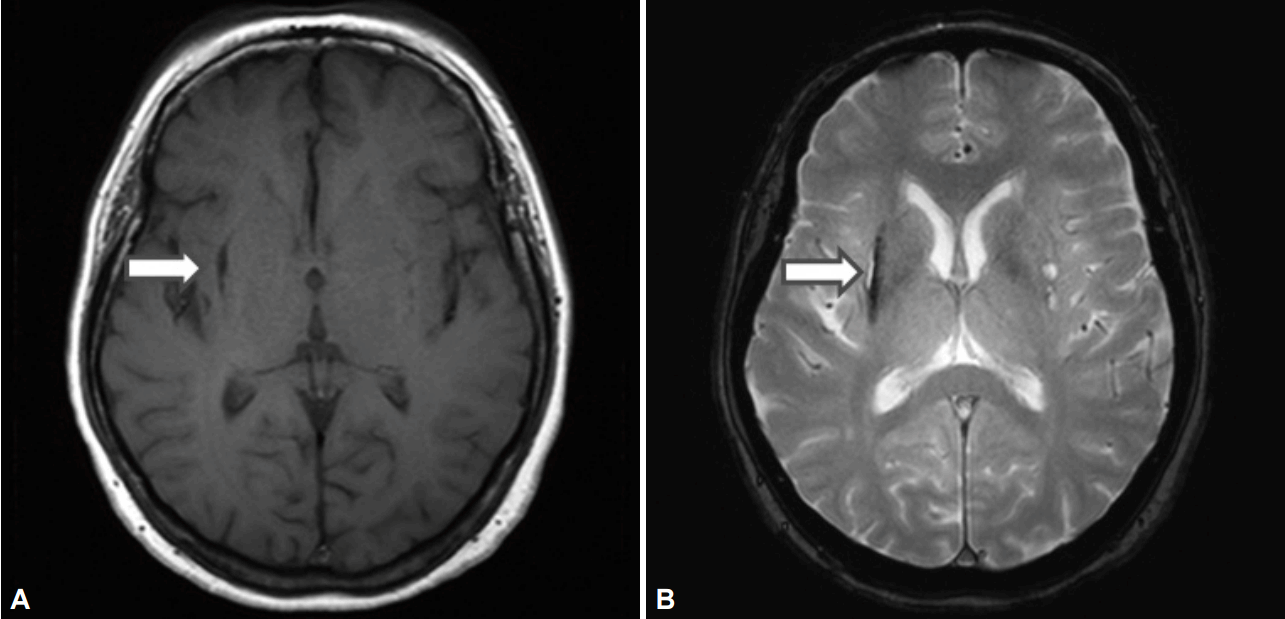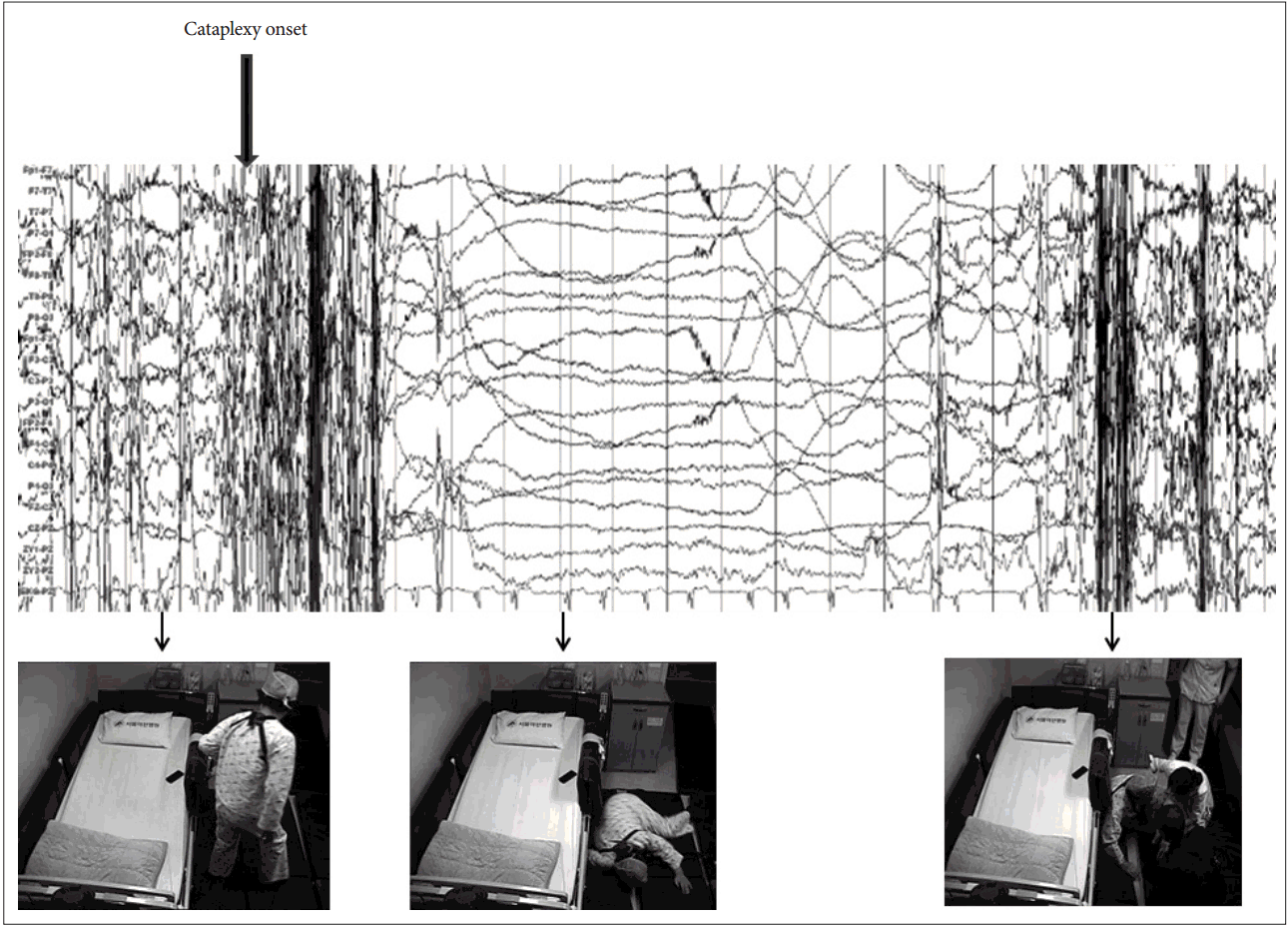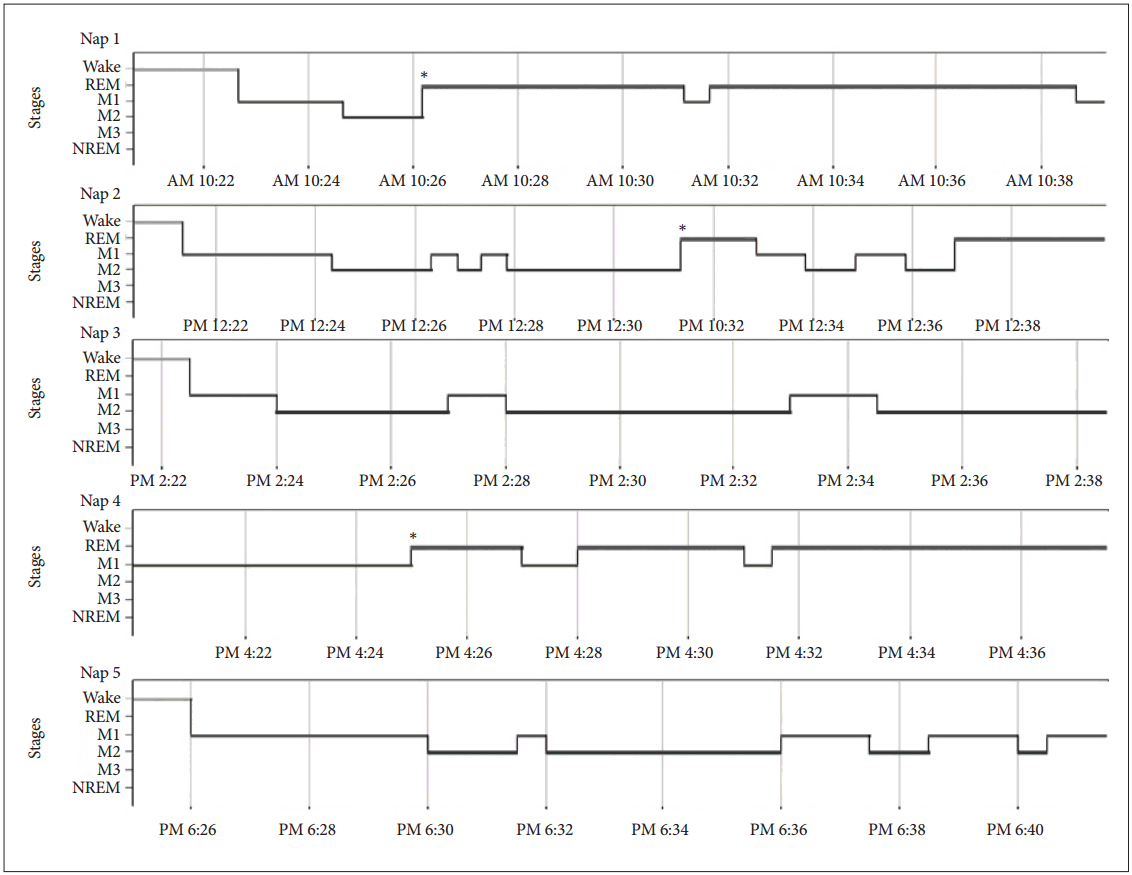INTRODUCTION
Narcolepsy type I is a disabling and underdiagnosed sleep disorder, affecting 0.02–0.06% of the adult population [1]. It is characterized by excessive day time sleepiness (EDS), cataplexy, sleep paralysis, hypnagogic hallucination, and fragmented night-time sleep [1,2]. Among these, EDS and cataplexy are the core symptoms for diagnosis of narcolepsy [3]. If the patient has unusual presenting symptoms of EDS and cataplexy, the diagnosis of narcolepsy remains unrecognized or delayed. We report an unusual narcolepsy patient with spontaneous cataplexy, without an identifiable trigger and subjective daytime sleepiness.
CASE REPORT
A 58-year-old Korean female presented with a 5-month history of recurrent drop attack. Eight months back, there was a sudden development of excessive daytime sleepiness, along with long sleep durations (more than 12 hours a day). These symptoms lasted three months, and then disappeared. She denied any subjective daytime sleepiness since then. She also denied any sleep paralysis and hypnagogic hallucination, but acknowledged fragmented night-time sleep. However, she started to experience drop attacks that made her abruptly fall down and injure herself, without any alteration of consciousness. Usually, only her lower limbs were involved in the attacks, but sometimes there was a complete weakness that involved both arms and face too. The duration of attacks was usually less than a minute. Its frequency varied from five to seven episodes per day, increasing gradually. She denied any emotional trigger factor for sudden fall, such as laughter, excitement, surprise and anger. However, the attacks usually occurred when she stood up, walked or spoke to people. There were no warning signs such as dizziness, hallucination or autonomic symptoms before the attack started.
The cardiac evaluation revealed normal electrocardiogram (EKG), 24-hour Holter recording, treadmill test and 2D echocardiogram. She was referred to the neurology department to evaluate any underlying neurologic problems. The initial presumptive diagnosis was epileptic drop attack or paroxysmal kinesogenic dyskinesia rather than narcolepsy, since she did not complain subjective daytime sleepiness nor did she have any identifiable emotional trigger before the event, except physical trigger such as walking and standing up. Neurological examination was normal. However, the brain magnetic resonance image showed old insult of hemorrhage alongside the right external capsule, of which the patient was unaware (Fig. 1). She underwent a 24-hour-video-electroencephalography (EEG) monitoring. During the monitoring, one episode of event occurred. Whilst walking around the room, she suddenly fell down and did not react for 15 seconds, after which she fully recovered (Fig. 2). She said that she did not lose her consciousness during the event. The EEG and EKG showed neither ictal epileptiform discharge nor arrhythmia. Although we did not record electromyography directly, the EEG certainly shows that muscle atnoia was present during the attack. Next, she underwent an overnight polysomnography (PSG), followed by a daytime multiple sleep latency test (MSLT). The Epworth Sleepiness Scale (ESS) was checked before starting the PSG study, where she had a 12 score point. PSG showed sleep onset rapid eye movement (SOREM) with 33.3/hr of total arousal index, and 24.9/hr of apnea-hypopnea index (Table 1). MSLT showed mean sleep latency of 1 min and three SOREM, indicating diagnosis of narcolepsy (Fig. 3). Neither cerebrospinal fluid hypocretin concentration measurement, nor the HLA-DQB1*0602 status was checked.
We concluded that the recurrent drop attacks are atypical forms of cataplexy with no emotional trigger factor, and treated her with clomipramine 25 mg each evening, gradually increasing up to 50 mg per day. The attacks dramatically subsided. However, there was a recurrence of EDS 2 months after the diagnosis of narcolepsy type I. We therefore prescribed modafinil 200 mg per day, following which the EDS symptom resolved.
DISCUSSION
Our case showed atypical presentation of narcolepsy type I. The patient did not have any emotional trigger for cataplexy, nor was there any complain of subjective daytime sleepiness. However, the diagnosis of narcolepsy was based on the result of the MSLT study, and by her dramatic improvement after using medical therapy. Narcolepsy type I have a wide range of clinical course and symptoms, and can be confused with other diseases such as epilepsy, syncope, drop attack, or psychiatric disorder. Very rarely, cases of isolated cataplexy (mostly familial) without sleepiness or any SOREM have also been reported [1].
Although our patient had no complaints of subjective sleepiness, the MSLT study showed that she definitely had objective daytime sleepiness. Several investigators have reported either no correlation or a low correlation between subjective sleepiness on the ESS and the objective sleepiness by MSLT [4]. One recent study showed that an ESS score ≥ 13 most effectively predicts an average sleep latency <8 minutes [4]. Our patient did not complain subjective sleepiness, even though she had ESS score of 12, which is greater than 10, which has been commonly used to define EDS [5]. There is a possibility that she had a high subjective sleepiness threshold due to her coexisting obstructive sleep apnea, or she did not recognize the subjective daytime sleepiness because sleep disturbance with frequent naps masked her symptom. However, it should be noted that there could be a disparity between subjective sleepiness and objective sleepiness.
Cataplexy is specific to narcolepsy and is the best diagnostic marker of the disease [1]. It is usually triggered by strong emotions, but our patient did not have any identifiable emotional trigger for cataplexy. Instead, she said that it usually occurred by movements such as standing up, walking, or talking with other people. Even though one study showed that nearly 60% of patients experienced spontaneous catapletic attack without an identifiable trigger, the frequency of spontaneous cataplexy is rare, and so far there have been no reports of any patient who consistently showed spontaneous cataplexy without emotional triggering [6]. This study also reported that physical exercise can sometimes evoke cataplexy [6]. Thus, clinicians should be aware of the wide variabilities of cataplexy expression, and try to identify as many different aspects of the presumed catapletic attacks.
In conclusion, narcolepsy presents with large phenotypical diversity and can be misdiagnosed as other disease. This case illustrates the importance of detailed clinical history and broad differential diagnosis, if there arises a suspicion of narcolepsy.














